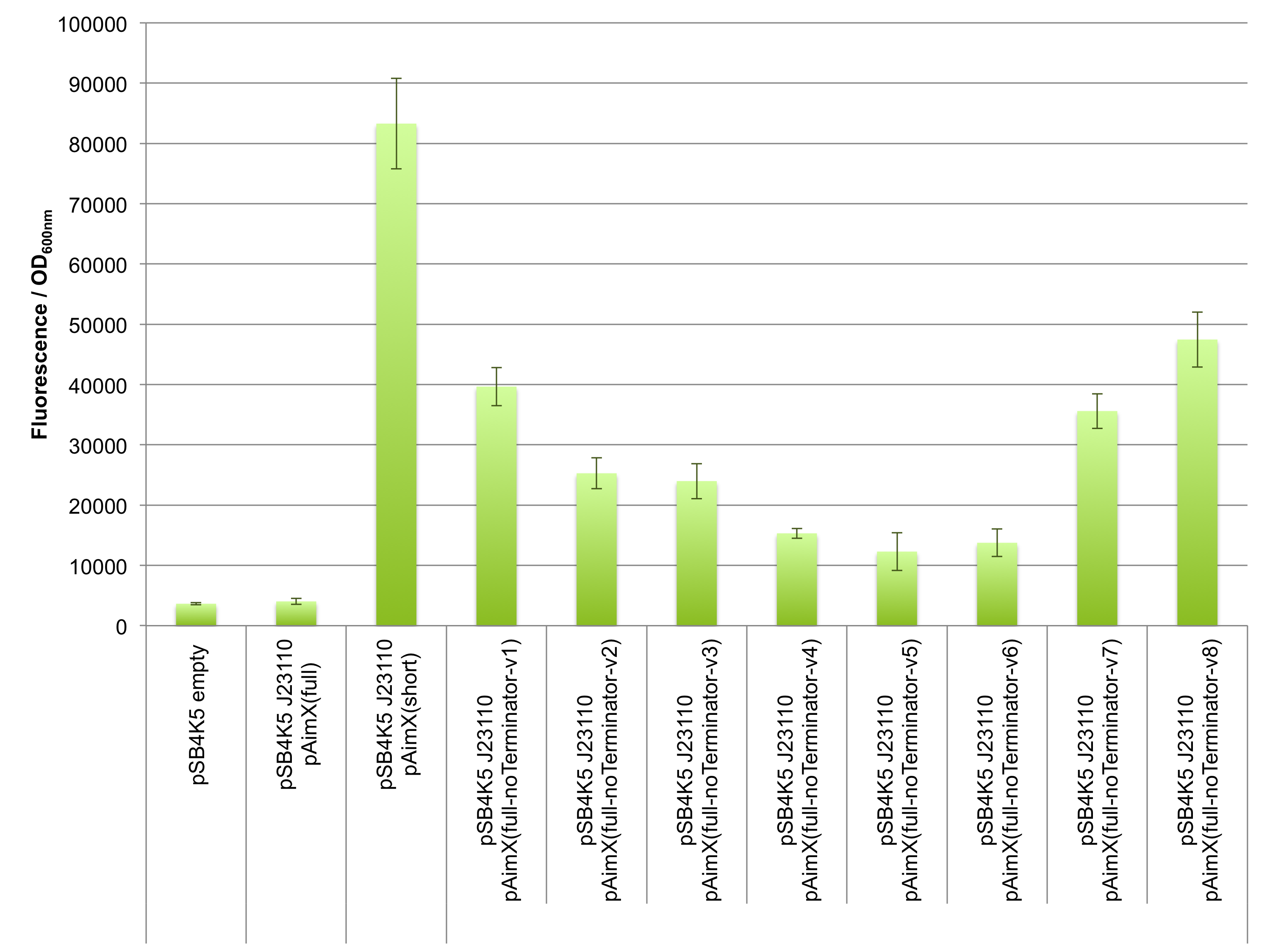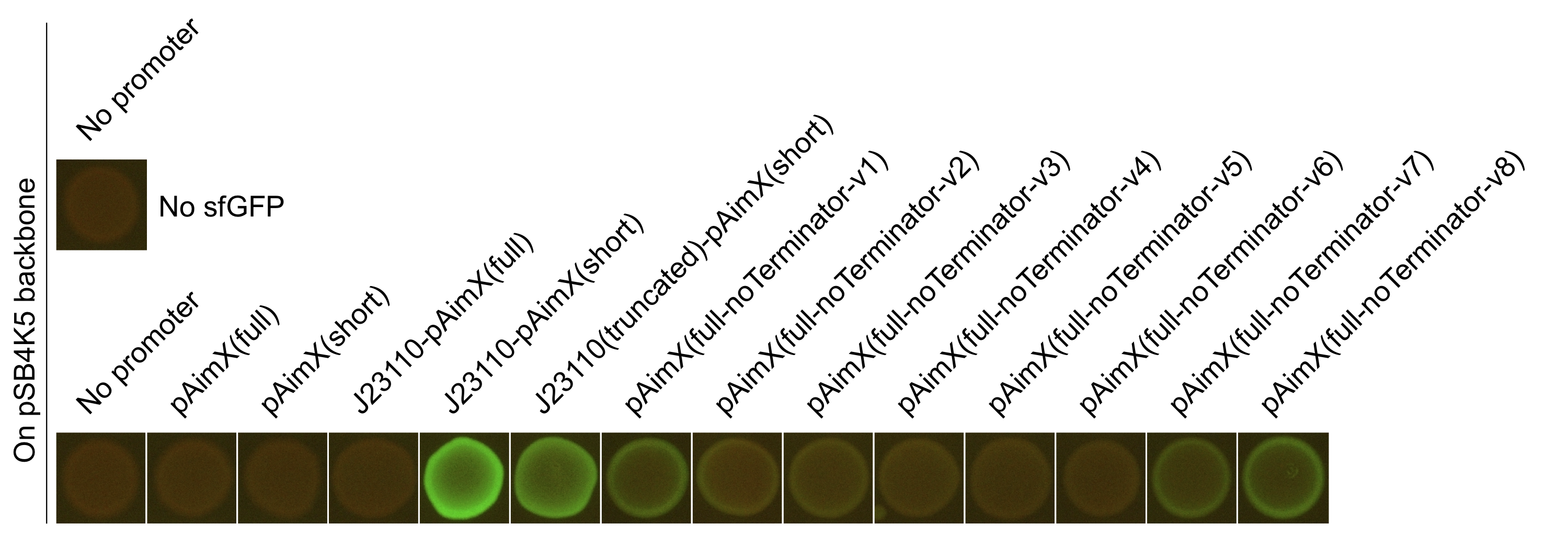Part:BBa_K2675194
sfGFP-LVAtag expression cassette under the control of J23110 and pAimX(full-noTerminator-v5) promote
This part is an sfGFP-LVAtag (BBa_K2675006) expression cassette under the control of a composite promoter: BBa_J23110 followed by the pAimX(full-noTerminator-v5) promoter of phage phi3T (BBa_K2675094).
Usage and Biology
The switch from lytic-to-lysogenic cycle of the Bacillus phage phi3T is based on the expression of a single transcript, AimX [1]. The expression of AimX is controlled by the transcriptional regulator AimR (BBa_K2279000) which is inactivated upon binding of the ‘arbitrium’ hexapeptide SAIRGA.
The transcription of AimX is driven from the intergenic region between AimP and AimX which we will refer to as pAimX(full) promoter (BBa_K2675020). This corresponds to nucleotides 70182 to 70313 of Phi3T phage genome (GenBank KY030782.1).
We have analysed the sequence of the pAimX(full) promoter using various available tools like the [http://www.fruitfly.org/seq_tools/promoter.html/ Neural Network Promoter Prediction web server], [http://linux1.softberry.com/berry.phtml?topic=bprom&group=programs&subgroup=gfindb BPROM websever] [2] or [http://rna.igmors.u-psud.fr/toolbox/arnold/index.php ARNold] [3, 4]. These sequence analyses revealed the presence of three putative promoters that we denote pAimX(1), pAimX(2) and pAimX(3), but also of an inverted repeat sequence potentially forming the stem-loop structure of a terminator.
pAimX(full) (BBa_K2675020) proved not to be an active promoter in E. coli (for further details, visit the BBa_K2675050 and BBa_K2675060 page in the registry).
In addition, pAimX(full) (BBa_K2675020) was not able to act as an operator for J23110 promoter in E. coli (for further details, visit the BBa_K2675057).
To test if this predicted terminator is indeed responsible for this effect, we randomised the left arm of the terminator stem or the poly-U tail as two different strategies of disrupting the predicted terminator (in BBa_K2675057). Since intrinsic termination depends on both a strong hairpin and a downstream polyU signal [5], we expect that disrupting either of them should restore fluorescence from these constructs. From the library we generated, we selected 8 colonies that appeared to be fluorescent on plates.
Sequencing revealed various mutations and insertions in the terminator region (Figure 1) that lead to various degrees of sfGFP expression initiated at the upstream J23110 promoter (Figures 2 and 3). Terminator versions 1 (BBa_K2675090), 2 (BBa_K2675091), 7 (BBa_K2675096) and 8 (BBa_K2675097) where termination efficiency is most severely reduced were designed to disrupt the polyU tail, while versions 3 (BBa_K2675092) to 6 (BBa_K2675025) were designed to disrupt the hairpin loop. These results suggest that the predicted hairpin loop in the pAimX(full) promoter is indeed an active terminator in E. coli, and possibly also in Bacillus. If the predicted hairpin in the pAimX(full) sequence acts like an intrinsic terminator in Bacillus it is possible that the activating function of AimR is in fact an antitermination function, consistent with other phages where the antitermination mechanism is used for infection cycle regulation [6]. That said, the fact that in our experiments expression from the composite promoter J23110 + pAimX(short) is regulated by AimR (BBa_K2675058 and BBa_K2675059), while that from J23110 + pAimX(full) (BBa_K2675057) is not, rules out an antitermination mechanism for regulation by AimR at least in E. coli.
Figure 1: pAimX(full) promoters of phage phi3T with mutations in the putative terminator. These mutations disrupted also the pAimX(2) and pAimX(3) putative promoters. -35 boxes are in green, -10 boxes in red and the transcription start sites in blue and indicated with + 1. The inverted repeat sequences potentially forming the stem-loop structure of a terminator are marked by open horizontal arrows.
Figure 2: In vivo characterization of sfGFP expression by E. coli cells harbouring the expression cassettes of sfGFP-LVAtag under the control of the composite promoter J23110 + pAimX(full) (BBa_K2675057), and its mutants where the internal terminator has been disrupted (BBa_K2675190, BBa_K2675191, BBa_K2675192, BBa_K2675193, BBa_K2675194, BBa_K2675195, BBa_K2675196 and BBa_K2675197). Fluorescence values were normalised by OD600nm.
Figure 3: Pictures of E. coli cells harbouring the expression cassettes of sfGFP-LVAtag under the control of pAimX(full) promoter (BBa_K2675050), pAimX(short) promoter (BBa_K2675051), J23110 + pAimX(full) promoter (BBa_K2675057), J23110 + pAimX(short) promoter (BBa_K2675058), J23110 truncated promoter (-10 only) + pAimX(short) promoter (BBa_K2675059) and a series of eight pAimX(full) derived promoters with with mutations in the putative terminator (BBa_K2675190, BBa_K2675191, BBa_K2675192, BBa_K2675193, BBa_K2675194, BBa_K2675195, BBa_K2675196 and BBa_K2675197).
References
[1] Erez Z, Steinberger-Levy I, Shamir M, Doron S, Stokar-Avihail A, Peleg Y, Melamed S, Leavitt A, Savidor A, Albeck S, Amitai G, Sorek R. Communication between viruses guides lysis-lysogeny decisions. Nature (2017) 541, 488-493.
[2] Solovyev V, Salamov A. Automatic Annotation of Microbial Genomes and Metagenomic Sequences. In Metagenomics and its Applications in Agriculture, Biomedicine and Environmental Studies (Ed. R.W. Li), Nova Science Publishers (2011) p. 61-78.
[3] Gautheret D, Lambert A. Direct RNA motif definition and identification from multiple sequence alignments using secondary structure profiles. J Mol Biol (2001) 313, 1003-1011.
[4] Macke T, Ecker D, Gutell R, Gautheret D, Case DA and Sampath R. RNAMotif – A new RNA secondary structure definition and discovery algorithm. Nucleic Acids Res (2001) 29, 4724–4735.
[5] Chen YJ, Liu P, Nielsen AA, Brophy JA, Clancy K, Peterson T, Voigt CA. Characterization of 582 natural and synthetic terminators and quantification of their design constraints. Nat Methods (2013) 10, 659-664.
[6] Herskowitz I, Hagen D. The lysis-lysogeny decision of phage lambda: explicit programming and responsiveness. Annu Rev Genet (1980) 14, 399-445.
Sequence and Features
- 10COMPATIBLE WITH RFC[10]
- 12INCOMPATIBLE WITH RFC[12]Illegal NheI site found at 7
Illegal NheI site found at 30 - 21COMPATIBLE WITH RFC[21]
- 23COMPATIBLE WITH RFC[23]
- 25INCOMPATIBLE WITH RFC[25]Illegal AgeI site found at 227
- 1000COMPATIBLE WITH RFC[1000]
| None |



